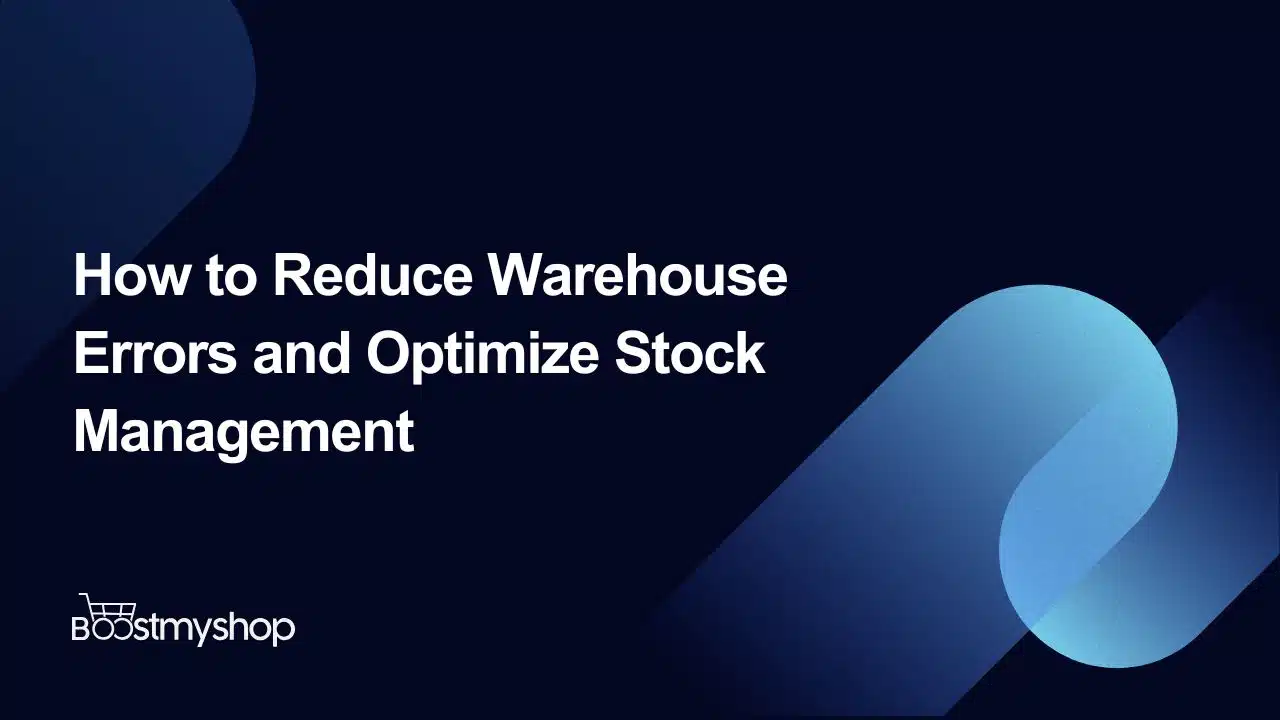Mastering Warehouse Management Systems (WMS) for E-commerce Growth
Warehouse Management Overview
A Warehouse Management System (WMS) is no longer a luxury but a necessity for scaling operations in today’s competitive landscape. Any business that stores items in a warehouse knows that effective management is the difference between fulfilling customer orders quickly and accurately while keeping costs down versus hearing complaints about delayed or inaccurate shipments and higher operating costs.
Whether you’re a small retailer looking to scale or a large enterprise managing complex operations, an efficient warehouse management can streamline processes, enhance efficiency, and drive business growth.
This comprehensive guide delves into the benefits of a WMS, how it supports predictive inventory management, facilitates integration with E-commerce CMS and links to tools like MyFulfillment, a solution for cloud-based inventory management, automated order fulfillment, and inventory optimization software.
Table of Contents
-
- What is Warehouse Management?
- Principles of Warehouse Management
- Warehouse Management Process
- Warehouse Optimization
- Tips to Improve Warehouse Management
- Inventory Management vs. Warehouse Management
- The Role of Warehouse Management in E-commerce
- What is a Warehouse Management System (WMS)?
- Benefits of Implementing a WMS
- Types of Warehouse Management Systems
- How a Warehouse Management System Works
- Key Features of a WMS
- Choosing the Right Warehouse Management System
What is Warehouse Management?
Warehouse management refers to the efficient and systematic control of various operations within a warehouse. At a high level, this includes receiving and organizing warehouse space, scheduling labor, managing inventory and fulfilling orders. Zoom in closer and you’ll see that effective warehouse management involves optimizing and integrating each of those processes to ensure all aspects of a warehouse operation work together to increase productivity and keep costs low.
Essentially, warehouse management refers to the process of managing inventory, organizing storage spaces, optimizing workflows, and ensuring that goods are received, stored, picked, packed, and shipped efficiently. The goal is to streamline operations, reduce costs, and enhance customer satisfaction by ensuring timely and accurate order fulfillment.
Principles of Warehouse Management
Whether managing inventory or streamlining the order fulfillment process, adhering to core principles ensures smooth operations and aligns your warehouse with the broader goals of scalability and customer satisfaction.
Here are the key principles of warehouse management:
Define Your Goals
Effective warehouse operations begin with a clear understanding of objectives. Are your customers expecting time-sensitive deliveries or does your inventory require temperature-controlled storage? Establishing these goals ensures that resources such as space, equipment, and labor are aligned to meet specific demands while optimizing efficiency and minimizing waste.
Achieve Comprehensive Oversight
Managing a warehouse involves coordinating an intricate web of processes, inventory tracking, equipment management, order handling, and workforce coordination. Supervisors must ensure every component operates seamlessly.
Adaptability and Robust Planning
Warehouses thrive on their ability to adapt to unexpected challenges. Whether it’s a delayed shipment, damaged goods, or surges in demand, being prepared to adjust operations is essential.
Customer-Centric Operations
Timely and accurate deliveries are the cornerstone of customer satisfaction. Warehouses must prioritize precision in picking and packing while ensuring prompt shipping. A streamlined operation leads to repeat business and bolsters brand reputation by consistently meeting customer expectations.
Leverage Data for Insights
Even well-running processes can benefit from data-driven refinement. Modern warehouse management systems (WMS) provide detailed analytics, allowing managers to identify inefficiencies, evaluate performance metrics, and make informed decisions. This proactive approach leads to continuous improvement and operational excellence.
By embracing these principles, warehouses can create an agile, customer-focused, and data-empowered operation ready to tackle the evolving demands of e-commerce and beyond.
Warehouse Management Processes
Ever imagined what exactly happens in an ecommerce business’s warehouse?
Here are eight essential activities commonly found in e-commerce warehouses to keep running the operations smoothly:
Receiving Goods
Before anything else, the warehouse must accept incoming inventory. During this process:
-
-
-
Warehouse staff unloads goods from trucks at the dock.
-
They count and inspect items to confirm correct quantities and good condition.
-
Documentation ensures the inventory is recorded properly in your system, ready for the next steps.
-
-
Putaway
After receiving inventory, it’s time to move items to their designated storage areas. Putaway strategies vary depending on:
-
-
-
The type and volume of products.
-
The layout and capacity of your warehouse.
-
Storage needs like temperature control or accessibility.
-
-
Adopting an efficient putaway approach helps streamline retrieval and maximizes warehouse space.
Inventory Storage
Storing goods until they’re needed is a vital function. Most warehouses:
-
-
-
Use pallets, racks, or bins to organize stock by SKU.
-
Strategically place high-demand items in easily accessible locations to speed up operations.
-
-
Effective inventory storage reduces retrieval time and prevents disorganization.
Picking
When a customer places an order, the warehouse picks the required items. This process can be optimized using different picking methods:
-
-
-
Zone Picking: Workers focus on specific areas.
-
Batch Picking: Collecting multiple orders at once.
-
Wave Picking: Coordinating batches with shipping schedules.
-
-
Automation tools and pick lists help ensure accuracy and efficiency during this stage.
Packing
After picking, items move to the packing station, where they are securely prepared for shipping. This includes:
-
-
-
Using appropriate packaging to prevent damage.
-
Adding packing materials like bubble wrap or fillers.
-
Labeling the package for its next destination.
-
-
Proper packing ensures orders arrive intact, enhancing customer satisfaction.
Shipping
Shipping carriers like FedEx, UPS, and DHL pick up packaged orders from the warehouse for delivery. A Warehouse Management System (WMS) can:
-
-
-
Automatically share tracking information with customers.
-
Ensure that orders are dispatched on time to meet delivery commitments.
-
-
Timely and accurate shipping is critical to building customer trust.
Slotting
Slotting is all about organizing your warehouse for peak efficiency. This involves:
-
-
-
Arranging products based on demand patterns and accessibility.
-
Optimizing space to reduce travel time for pickers.
-
-
A well thought out slotting plan can cut operating costs and boost overall productivity.
Reporting and Analysis
Accurate reporting keeps operations transparent and helps identify areas for improvement. With a WMS, you can track:
-
-
-
Order fulfillment accuracy and speed.
-
Inventory forecasting to manage stock levels.
-
Employee performance metrics, like tasks completed per hour.
-
-
Warehouse Optimization
Warehouse optimization involves refining various processes to improve operational efficiency. For example, during the receiving process, businesses can enhance inventory tracking by labeling items with mobile barcodes or RFID tags, making them easier to locate during the picking phase. In the put-away process, space optimization is key—storing products in the smallest amount of space possible to maximize warehouse capacity. Additionally, best practices for optimization include placing high-demand items in easily accessible locations and ensuring that similar-looking products are stored separately to prevent picking errors.
Tips to Improve Warehouse Management
Automate Whenever Possible
Warehouse automation can significantly reduce the time spent on repetitive tasks. Automating processes like order processing, retrieval, and even certain aspects of picking can enhance fulfillment speeds and free up your workforce for more complex tasks. This also leads to a reduction in human error, helping to improve operational accuracy.
Prioritize Safety
A safe warehouse is an efficient one. Safety standards protect your workforce and minimize accidents, ensuring smoother operations and faster supply chain velocity. It’s vital to establish clear safety guidelines, conduct thorough employee training, and regularly audit spaces, equipment, and workflows for potential hazards.
Optimize Warehouse Space
Effective space management is essential for operational efficiency. Items should be stored in locations that maximize accessibility based on their demand. High-turnover products should be placed near shipping areas, and implementing strategies like vertical storage or dynamic slotting can help optimize space and reduce picking time.
Track Key Performance Indicators (KPIs)
Monitoring the right KPIs offers valuable insights into warehouse performance. Metrics related to inventory management, receiving, put-away, picking, and safety will help you identify areas for improvement. Focus on tracking the most relevant KPIs based on your operations and adjust your processes to drive efficiency and cost savings.
Focus on Employee Training
Regular employee training is crucial for enhancing warehouse efficiency. Your workforce should be well-versed in systems and processes, from safety protocols to inventory management and the use of warehouse technologies like mobile scanners or WMS systems.
Invest in a Warehouse Management System (WMS)
A Warehouse Management System (WMS) streamlines inventory control, order fulfillment, and real-time tracking. By automating key processes like picking, packing, and shipping, a WMS improves operational accuracy and coordination across your warehouse operations.
Efficient Warehouse Management Systems like myFulfillment offer a comprehensive, automated solution for inventory and warehouse management, optimizing all aspects of warehouse operations.
The Role of Warehouse Management in Ecommerce
As the backbone of operations, effective warehouse management contributes directly to customer satisfaction, cost savings, and streamlined processes.
Inventory Control
A well-managed warehouse helps eCommerce businesses track and manage inventory in real-time. It ensures products are stored efficiently, reducing excess inventory while preventing stockouts.
Warehouse Management Systems (WMS) like myFulfillment can help monitor stock levels and reorder products just in time, optimizing supply chain management and reducing costs.
Order Fulfillment
The process of picking, packing, and shipping orders quickly and accurately is central to meeting customer expectations. Warehouse management ensures that the correct products are picked and packed on time, which directly impacts delivery speed and accuracy.
Optimizing Space and Labor
Efficient warehouse operations use space and labor optimally to reduce costs. When done correctly, space management can increase warehouse capacity without adding additional space, which is vital for growing eCommerce businesses.
Tracking and Reporting
By incorporating real-time tracking and reporting, eCommerce businesses can monitor performance across key areas such as inventory levels, order accuracy, and shipping times.
Customer Satisfaction
Warehouse management directly affects customer satisfaction, as it influences order accuracy, shipping speed, and product availability. Quick fulfillment, accurate orders, and timely deliveries are crucial factors in building customer loyalty and trust.
What is Warehouse Management System?
A Warehouse Management System (WMS) is a software solution designed to manage and optimize daily warehouse operations. From the moment goods and materials arrive at a distribution or fulfillment center until they are dispatched, WMS software ensures everything is tracked and controlled efficiently. It plays a vital role in supply chain management, offering real-time visibility into inventory both inside the warehouse and in transit. Besides inventory control, a WMS streamlines processes like picking, packing, resource allocation, and provides valuable insights through analytics.
WMS systems, like MyFulfillment, are essential in modern supply chain management, enabling companies to maintain operational efficiency and meet customer demands.
Benefits of Implementing Warehouse Management System
As businesses expand, the complexity of managing inventory and warehouse operations also increases. This is where a Warehouse Management System (WMS) becomes essential. Implementing a WMS can revolutionize how businesses manage their inventory by automating key tasks, optimizing workflows, and providing real-time visibility into stock levels. With these improvements, a WMS helps businesses enhance productivity, reduce operational costs, and improve customer satisfaction, all of which are critical for sustaining growth and maintaining a competitive edge.
-
-
-
Improved Inventory Accuracy
A WMS provides real-time tracking of inventory, reducing the chances of human error in stock counting. This enhances inventory accuracy, enabling businesses to maintain the right stock levels and prevent stockouts or overstock situations. Accurate data also improves decision-making for purchasing and inventory planning. -
Enhanced Operational Efficiency
By automating tasks such as order picking, packing, and shipping, a WMS speeds up warehouse processes and reduces the time employees spend on repetitive manual tasks. It allows for optimized workflows, helping warehouses become more productive and improving turnaround times. -
Cost Reduction
A WMS minimizes waste and helps optimize space utilization within the warehouse. It can also improve labor efficiency, which reduces operational costs by making processes more streamlined and less dependent on manual labor. Over time, this leads to significant cost savings. -
Improved Customer Service
With a WMS in place, businesses can provide more accurate order fulfillment, ensuring that customers receive the right products on time. Real-time tracking enables better management of shipping times and improves overall delivery performance, which directly impacts customer satisfaction. -
Advanced Reporting and Analytics
A WMS offers detailed analytics and reporting features that help track key metrics such as inventory levels, order accuracy, and fulfillment rates. These insights allow warehouse managers to identify inefficiencies and make data-driven decisions to improve warehouse operations further. -
Scalability and Flexibility
As businesses grow, a WMS can scale to accommodate increasing order volumes and warehouse space. It can integrate with other enterprise systems, such as Enterprise Resource Planning (ERP) and Transportation Management Systems (TMS), allowing businesses to adapt to changing operational needs and complexities.
-
-
Inventory Management vs Warehouse Management
Inventory Management is the practice of forecasting, ordering, receiving, and allocating stock across the entire business. It involves analyzing historical sales data and trends to predict demand, ensuring that raw materials, parts, and finished products are available when needed.
Warehouse Management focuses on managing the storage, picking, and packing of goods within a warehouse. It uses demand data to optimize stock placement and improve shipping efficiency, ensuring that fast-moving items are stored closer to packing areas, and prioritizing items with impending expiration dates.
Similarities: Both practices aim to ensure smooth inventory flow from supplier to consumer. They utilize technology such as RFID, barcodes, and specialized software to improve accuracy, streamline processes, and offer real-time visibility into inventory status.
Key Differences:
-
-
-
Inventory Management: Oversees overall stock levels, tracks sales trends, and calculates reorder points to ensure stock availability.
-
Warehouse Management: Focuses on the internal movement of stock within the warehouse, optimizing storage space, picking accuracy, and task efficiency.
-
-
Types of Warehouse Management Systems
-
-
-
Standalone WMS
A standalone WMS operates independently, focusing purely on warehouse operations like inventory management, picking, and shipping. It often integrates with other software systems like Enterprise Resource Planning (ERP) or Order Management Systems (OMS) to facilitate end-to-end supply chain management. -
Integrated WMS
An integrated WMS works in conjunction with other enterprise software, such as ERP or Warehouse Control Systems (WCS), allowing for seamless data sharing across different operations. This type of WMS helps businesses centralize their operations and make data-driven decisions across the entire organization. -
Cloud-Based WMS
A cloud-based warehouse management WMS operates via the cloud, allowing users to access it from anywhere. It offers the advantage of easy scalability, low upfront costs, and minimal IT infrastructure. This type of WMS is ideal for businesses that operate across multiple locations and need real-time visibility into their warehouse operations. -
On-Premise WMS
On-premise WMS is hosted on a company’s internal servers, providing complete control over the system’s configuration and security. While it requires more investment upfront and ongoing maintenance, it offers high customization and control, making it suitable for businesses with complex warehouse needs.
-
-
How Warehouse Management System works?
A Warehouse Management System (WMS) automates various warehouse processes to ensure efficient management of inventory, order fulfillment, and logistics. Here’s how it typically works:
Inventory Tracking
The WMS tracks inventory in real-time, logging every movement from the moment it enters the warehouse until it is shipped out. This helps to maintain accurate stock levels and provides visibility into the location of every item.
Order Processing
When an order is placed, the WMS triggers the picking, packing, and shipping processes. It helps warehouse staff quickly locate items, manage stock movements, and prepare orders for shipping.
Optimizing Storage
The WMS uses algorithms to determine the most efficient storage location for goods based on their size, weight, and demand. High-demand items are placed near shipping areas to reduce picking times.
Shipping and Delivery
Once an order is packed, the WMS ensures that it is shipped using the most cost-effective carrier and method. It can also provide real-time tracking information for both the business and the customer.
Data Analysis and Reporting
The WMS collects data on inventory levels, order fulfillment, and warehouse performance, providing insights into areas for improvement. This helps businesses optimize their operations and increase efficiency
Features of Warehouse Management System
Real-Time Inventory Tracking
A WMS tracks inventory in real time, providing businesses with an up-to-the-minute view of stock levels. This feature helps prevent stockouts and overstocking by ensuring inventory is replenished as needed.
Order Fulfillment Optimization
The system optimizes order picking, packing, and shipping. It can employ strategies like zone picking, wave picking, or batch picking to streamline these processes and increase accuracy.
Warehouse Layout Management
A WMS helps optimize warehouse space by suggesting the best locations for storing inventory based on product demand, size, and other factors. This reduces picking time and enhances space utilization.
Reporting and Analytics
WMS systems generate detailed reports on key performance metrics such as order fulfillment accuracy, inventory turnover, and employee productivity. These reports provide actionable insights to improve efficiency and reduce costs.
Barcode and RFID Integration
Most modern WMS solutions integrate with barcode scanners and RFID technology to facilitate quick and accurate data entry. This helps track goods throughout the warehouse and reduces human errors.
Shipping Integration
A WMS can be integrated with shipping carriers (e.g., FedEx, UPS) to automatically select the best shipping method, print shipping labels, and provide tracking details to customers.
By automating processes and providing real-time visibility, a WMS ensures that warehouse operations run smoothly and efficiently, contributing to better customer satisfaction and cost savings.
Choosing the right Warehouse Management System
Selecting the right Warehouse Management System (WMS) depends on your warehouse’s specific needs and goals. The primary objective is to improve efficiency and accuracy in order fulfillment, ultimately reducing costs and maximizing ROI. A well-suited WMS will support your team by providing real-time insights into every aspect of warehouse operations—such as receiving, shipping, inventory management, order fulfillment, and labor. These actionable insights help staff work more efficiently, while easy-to-understand reports ensure that both managers and workers can make informed decisions to improve daily operations and long-term performance.
Moreover, the ideal WMS should be scalable to accommodate business growth and adapt to market changes. A robust WMS can significantly enhance warehouse operations, boosting efficiency, speed, and order accuracy, while helping your company stay competitive and keep operational costs in check.






